A master hairstylist with refined skills and extensive experience is often the first line of defense when identifying various scalp, skin, and hair conditions. Their close proximity to the skin equips them to detect abnormalities that might otherwise go unnoticed. Master hairstylists have an educated understanding of skin and hair health. Today’s blog post will discuss all the skin and hair conditions master hairstylists can identify. We will highlight their significance, symptoms, and potential health implications for the client.
Dandruff (Seborrheic Dermatitis)
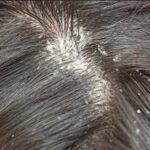
Description: The technical term for dandruff is seborrheic dermatitis when it affects the scalp skin. It is a common condition characterized by flaky, itchy skin. Dandruff often appears as white or yellowish scales on the scalp, sometimes accompanied by redness and irritation. It also has a distinct smell related to the sebaceous oil secreted.
Identification by a Hairstylist: A master hairstylist can easily spot dandruff during a routine service by examining the scalp. The first noticed is excessive flaking, particularly when brushing or styling the hair. The greasy patches and an oily scalp, combined with these flakes, can further indicate seborrheic dermatitis. Hairstylists might also observe that the condition worsens in colder weather or during periods of stress.
Significance: While dandruff is typically not a serious condition, it can cause discomfort and self-consciousness for the client. Chronic dandruff may also indicate other underlying skin conditions requiring medical attention, such as psoriasis or eczema.
Recommendation: Invest in a professional dandruff shampoo that contains zinc oxide and use it consistently. FOR MEN Salon | Spa uses and recommends the Nioxin Scalp Recovery kit.
Scalp Alopecia Areata
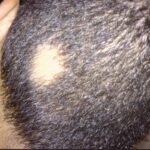
Description: Alopecia areata is an autoimmune disorder that causes sudden, patchy hair loss. The condition occurs when the immune system mistakenly attacks hair follicles, causing hair to fall out in round or oval patches. Two additional forms of alopecia are more severe. They are Alopecia Totalis and Alopecia Universalis.
Identification by a Hairstylist: A skilled hairstylist will likely notice the small, smooth, round bald patches typical of alopecia areata. These patches are often completely hairless with no signs of inflammation or scaling. The hairstylist may also observe short, broken hairs at the edges of the bald patches, known as “exclamation point” hairs.
Significance: Alopecia areata can be distressing for clients due to the visible hair loss and the uncertainty of its progression. Early detection by a hairstylist can prompt clients to seek medical intervention. Early medical attention may help manage the condition and potentially slow its progression.
Recommendation: Consult a dermatologist or healthcare provider for an official diagnosis and medical treatment..
Scalp Psoriasis
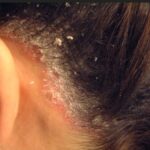
Description: Psoriasis is a chronic autoimmune skin condition that causes rapid skin cell turnover. This leads to thick, scaly patches of skin. It can be particularly challenging to manage when it affects the scalp due to the hair covering the area.
Identification by a Hairstylist: A master hairstylist may notice thick, red, and scaly plaques on the scalp. Psoriasis often extends beyond the hairline. These plaques can appear silver or white and may be accompanied by itching or discomfort. Unlike dandruff, the scales associated with psoriasis are typically thicker and more adherent to the skin.
Significance: Psoriasis is more than just a cosmetic issue. It can be extremely painful and itchy. It can also create social anxiety. Psoriasis may also be associated with other health conditions, such as psoriatic arthritis. A hairstylist’s ability to recognize the signs of scalp psoriasis can lead to an early diagnosis and treatment. Early detection can potentially improve the client’s quality of life.
Recommendation: We encourage clients to seek advice from a dermatologist or healthcare provider for medical treatments, such as medicated shampoos, topical treatments, or phototherapy.
Tinea Capitis (Scalp Ringworm)
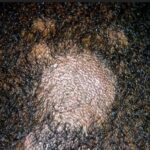
Description: Tinea capitis, known as scalp ringworm, is a fungal infection affecting the scalp and hair shafts. It is characterized by circular, scaly patches that can lead to hair loss in the affected areas.
Identification by a Hairstylist: A hairstylist may notice round, bald patches on the scalp, often with a scaly, red border. The hair within these patches may be broken off at the scalp, giving the area a “stubbly” appearance. The presence of black dots and broken-off hairs is another telltale sign of tinea capitis.
Significance: Tinea capitis is highly contagious and can spread quickly, especially among children. Early detection by a hairstylist can prevent further spread and encourage prompt treatment with antifungal medications.
Recommendation: See a medical professional for proper diagnosis and prescribed medication.
Folliculitis
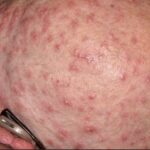
Description: Folliculitis is an inflammation of the hair follicles. Bacterial or fungal infections often cause it. It presents as small, red bumps or pimple-looking bumps around the hair follicles. Folliculitis may be itchy or painful.
Identification by a Hairstylist: A hairstylist may observe small, red, and inflamed bumps on the scalp. These bumps often resemble acne. They may be filled with pus and can become crusted over time. The hairstylist might notice scarring or hair loss in the affected areas in severe cases.
Significance: While folliculitis is generally not serious, it can cause discomfort. If left untreated, it can, in severe cases, lead to permanent hair loss. A hairstylist’s recognition of this condition can prompt early intervention, reducing the risk of complications.
Recommendation: See a dermatologist for proper diagnosis. People with folliculitis may also benefit from targeted chryotherapy treatments. See our recommendation in the section of alopecia areata. FOR MEN Salon | Spa also recommends shampoo bars for clients with folliculitis. Their clean ingredients and gentle sulfates do not irritate the scalp like typical plastic bottle shampoos do.
Scalp Lichen Planopilaris
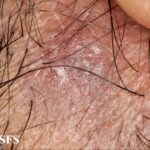
Description: Lichen planopilaris is a rare inflammatory condition that affects the scalp and hair follicles. It is a type of lichen planus that specifically targets the hair follicles. This condition can lead to scarring and permanent hair loss.
Identification by a Hairstylist: A master hairstylist may notice small, reddish, or purplish bumps on the scalp. These bumps are often accompanied by scarring and hair loss. The affected areas may be tender, and the hair follicles may appear inflamed or plugged. The hairstylist might also observe a shiny appearance on the scalp in areas where hair has been lost.
Significance: Lichen planopilaris can cause irreversible hair loss if not treated promptly. Early detection by a hairstylist can lead to a quicker diagnosis and more effective management of the condition. Potentially preserving the client’s remaining hair.
Recommendation: See a dermatologist or primary care provider for professional diagnosis and treatment options.
Androgenetic Alopecia (Male and Female Pattern Baldness)
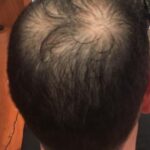
Description: Androgenetic alopecia is a common form of hair loss in men and women. A gradual thinning of the hair characterizes it. In men, it typically presents as a receding hairline and thinning at the crown. In women, it usually manifests as diffuse thinning across the top of the scalp.
Identification by a Hairstylist: A hairstylist is well-positioned to notice the early signs of androgenetic alopecia, such as thinning hair or widening part lines. The hairstylist may observe a receding hairline or thinning at the temples in men. Women may notice a reduction in hair volume or a more visible scalp through the hair.
Significance: Androgenetic alopecia is often a source of anxiety for clients due to its impact on appearance. This condition is mainly genetic and not preventable. However, early detection by a hairstylist can lead to discussions about treatment options. Today, numerous treatment options exist, such as topical Minoxidil or Propecia. There are new over-the-counter options, too, like Nutrolfol and HIMS.
Recommendation: Seek medical advice for prescription options. A hairstylist can offer their knowledge on over-the-counter treatments and suggest shampoo/conditioners that slow down the hairloss process. FOR MEN Salon | Spa uses and recommends Nioxin. Nioxin is designed to keep hair in the longest growth phase. This phase is known as the telegen phase.
Telogen Effluvium
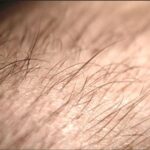
Description: Telogen effluvium is a form of temporary hair loss that occurs when a large number of hair follicles enter the telogen (resting) phase simultaneously. It is often triggered by stress, illness, or hormonal changes.
Identification by a Hairstylist: A hairstylist may notice increased hair shedding during brushing or washing. The hair may appear thinner overall, but no distinct bald patches usually exist. The stylist might also observe a more diffuse pattern of hair loss rather than localized thinning.
Significance: Telogen effluvium is often temporary but can be distressing for clients. A hairstylist’s ability to recognize this condition can reassure the client. They will also encourage clients to seek medical advice if necessary.
Recommendation: Try using a shampoo and conditioning systems designed to slow down the hairloss process. FOR MEN Salon | Spa uses and recommends Nioxin products for this condition. Nioxin is designed to slow down the shedding phase by strengthening and nourishing the papila.
Contact Dermatitis
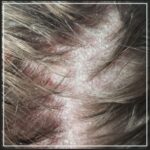
Description: Contact dermatitis is an inflammatory skin reaction caused by direct contact with an irritant or allergen. It can be triggered on the scalp by hair care products, dyes, or other chemicals.
Identification by a Hairstylist: A hairstylist may notice redness, swelling, or blistering on the scalp. Contact dermatitis is often accompanied by itching or burning. The affected area may also appear dry or scaly. If the reaction is severe, the hairstylist might observe oozing or crusting on the skin.
Significance: Contact dermatitis can be uncomfortable and unsightly. If left untreated, it can lead to more serious skin issues. A hairstylist can help identify potential triggers and recommend hypoallergenic products or treatments to alleviate symptoms.
Recommendation: A zinc-based shampoo and conditioner typically helps to calm the itching of contact dermatitis. To address this condition long term, FOR MEN Salon | Spa recommends clients use shampoo and conditioning bars. These bars are typically free of ingredients that plastic bottled shampoos contain.
Pityriasis Amiantacea
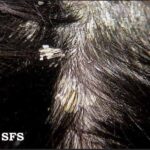
Description: Pityriasis amiantacea is a scalp condition characterized by thick, silvery scales that cling to the hair shafts, often in a “sheath-like” manner. It is sometimes associated with other scalp conditions, such as psoriasis or seborrheic dermatitis.
Identification by a Hairstylist: A hairstylist may observe thick, adherent scales on the scalp, often forming a crust that sticks to the hair strands. The scalp may appear inflamed or red beneath the scales, and there may be some hair loss in the affected areas.
Significance: Pityriasis amiantacea can be persistent and difficult to treat, leading to discomfort and embarrassment for the client. Early detection by a hairstylist can prompt treatment, which may involve medicated shampoos or topical corticosteroids.
Recommendation: Adressing this condition as early as possible is key. Dermatologists suggest using oils, especially olive oil, to loosen the adherent scales. They also recommend shampoos containing salicylic acid, coal tar and sulphur. These shampoos help in reducing the scaling and inflammation. Lastly, perscription anti-fungal shampoos, like ketoconazole or ciclopirox, are helpful for cases involving seborrhoeic dermatitis.
Scalp Acne
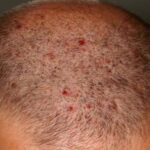
Description: Scalp acne is when the hair follicles become clogged with oil and dead skin cells, leading to pimples or cysts on the scalp. It can range from mild blackheads and whiteheads to more severe, painful cysts.
Identification by a Hairstylist: A hairstylist may notice small, raised bumps or pustules on the scalp, often accompanied by redness or inflammation. In more severe cases, the stylist might observe larger, painful cysts that can lead to scarring and hair loss if left untreated.
Significance: Scalp acne can be uncomfortable and may affect a client’s confidence. A hairstylist’s recognition of this condition can lead to recommendations for appropriate treatments, such as medicated shampoos or referral to a dermatologist.
Recommendation: Try wwitching to a shampoo, conditioner, and hairstyling products that do not contain any oil. Check the label and look for products that indicate they are:
- Oil free
- Non-comedogenic
- Hypoallergenic
- Anti-acnegenic
- Won’t clog pores
FOR MEN Salon | Spa recommends keeping dirt, oil, and sweat off your scalp. This will help keep pores clean. Try keeping cleansing wipes and/or oil botters handy and use them throughout the day.
Scalp Seborrheic Keratosis
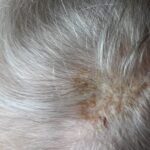
Description: Seborrheic keratosis is a benign skin growth that appears as a brown, black, or light tan lesion on the scalp. While more common on other body parts, these growths can occasionally appear on the scalp.
Identification by a Hairstylist: A hairstylist may notice a raised, wart-like lesion on the scalp. These growths often have a waxy or “stuck-on” appearance and can vary in size and color. They may sometimes be mistaken for moles or warts.
Significance: Seborrheic keratosis is typically harmless, but its appearance can concern clients. A hairstylist’s identification of these lesions can provide reassurance and, if necessary, lead to further examination by a healthcare professional.
Recommendation: See a dermatologist or primary care provider for professional diagnosis and treatment options.
Scalp Sunburn
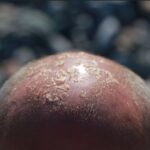
Description: Scalp sunburn occurs when the scalp is overexposed to ultraviolet (UV) rays. Overexposure to the sun leads to redness, pain, and peeling. This is more common in individuals with thinning hair or bald patches.
Identification by a Hairstylist: A hairstylist may notice redness, tenderness, or peeling skin on the scalp. Particularly in areas where the hair is thin or absent. The client may also complain of pain or sensitivity when touching the scalp after being in the sun for an extended period.
Significance: Scalp sunburn can be painful and increase the risk of skin cancer. A hairstylist can advise clients on the importance of sun protection for the scalp.
Recommendation: Master hairstylists will recommend wearing hats or scalp sunscreen sprays. They will also recommend a scalp conditioning treatment in cases causing major discomfort. If a scalp sunburn occurs, skip shampoos and conditioners containing sulfates. Discontinue haircare products and usinf a hairdryer until the sunburn has healed.
Vitiligo Hair
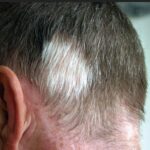
Description: Vitiligo is a skin condition characterized by the loss of pigment, resulting in white patches of skin. When it affects the scalp, it can lead to white patches of hair, sometimes called “poliosis.”
Identification by a Hairstylist: A hairstylist may notice patches of white hair, often associated with depigmented skin on the scalp. These patches can vary in size and may spread over time.
Significance: Vitiligo is a chronic condition. It is manageable when it is present on the scalp. A hairstylist’s recognition of vitiligo can lead to conversations and recommendations for hair coloring to manage the condition.
Recommendation: When vitiligo affects hair color, hair dye can be used to cover the non-pigmented patches. Dermatologists advise clients to use caution when dying vitiligo hair. In some cases, hair dye can make it worse. FOR MEN Salon | Spa recommends a haircolor patch test before proceeding with this service.
Scalp Pityriasis Rosea
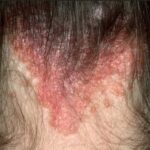
Description: Pityriasis rosea is a skin condition that typically presents as a large, scaly, pink patch followed by smaller patches on the body. It can sometimes affect the scalp, leading to scaly patches and hair loss. This condition can be confused with psoriasis or ringworm. Medical professionals are best at diagnosing this condition.
Identification by a Hairstylist: A hairstylist may observe pink, scaly patches on the scalp. Unique to this condition, it is often accompanied by hair loss in the affected areas. The patches may appear ring-like, and the client may report itching or discomfort.
Significance: Pityriasis rosea is usually self-limiting, but its appearance can concern clients. A hairstylist’s ability to recognize the condition can reassure and encourage the client to seek medical advice.
Recommendation: Seek proper diagnosis from medical professionals.
Hair Shaft Disorders
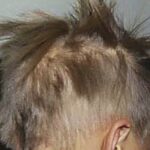
Description: Hair shaft disorders affect the structure and integrity of the hair shaft, leading to fragile, easily breakable hair. These disorders can be genetically acquired. It may present as hair that is dry, brittle, or prone to splitting.
Identification by a Hairstylist: A master hairstylist may notice excessively dry, rough, or prone to breakage hair. The hair may appear frizzy or have split ends. In severe cases, the stylist might observe thinning areas or short, broken hair.
Significance: Hair shaft disorders can be frustrating for clients. This condition may affect their overall hair health and appearance. A hairstylist’s ability to identify these issues can lead to recommendations for appropriate hair care products and treatments. Leading to the improvement of the hair’s condition.
Recommendation: Gentle hair care methods are advised and short hairstyles are recommended. Try to avoid excessive grooming, heat treatments, and chemical services. It is best to wash hair using a gentle shampoo and use conditioner with every shampoo. If using a hairdryer, use it on the cool setting. FOR MEN Salon | Spa can help clients suffering from hair shaft disorders to find the best haircut for their particular case. We can also recommend the right haircare products that will help hair be more manageable.
Hair Dye Reactions
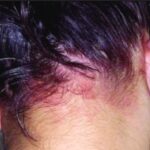
Description: Hair dye reactions occur when a client has an allergic or irritant response to hair coloring products. This can result in redness, swelling, itching, or even blistering on the scalp.
Identification by a Hairstylist: A hairstylist may notice signs of irritation or an allergic reaction on the scalp, such as redness, swelling, or a rash. In severe cases, the stylist might observe blisters or oozing sores. The client may also complain of itching or burning sensations during or after dyeing.
Significance: Hair dye reactions can be uncomfortable but tolerable. However, in some cases, it can be dangerous. A hairstylist’s ability to recognize these reactions and take immediate action is essential. They will rinse the dye immediately and recommend medical attention in severe cases. This will help to prevent more severe complications.
Recommendation: PPD is the ingredient most often associated with a hair dye allergy. It is best to find hair dyes without PPD. Master hairstylists have discovered a hack for clients that have a mild allergy to hair dye. FOR MEN Salon | Spa always recommends a hair color patch test before a hair dye service to test a client’s scalp reaction. For clients who have a severe allergic reaction to hair dye, we recommend avoiding this service.
A Master Hairstylist’s Conclusion
A master hairstylist’s role extends beyond cutting, coloring, and styling hair. Their close and frequent contact with the scalp and hair makes them valuable allies in detecting various conditions early. From common issues like dandruff and androgenetic alopecia to more severe conditions such as scalp lichen planopilaris, hairstylists are often the first to notice subtle changes that may indicate underlying health concerns.
Identifying these conditions helps preserve the client’s hair and scalp health. It also plays a crucial role in promoting overall well-being. By staying informed about the signs and symptoms of these conditions, master hairstylists can offer clients both aesthetic services and essential health insights. Making them indispensable partners in the journey toward maintaining healthy hair and skin.
FOR MEN Salon and Spa Can Help
FOR MEN Salon | Spa hosts talented and highly educated stylists who can spot various scalp and hair conditions. Our own Krista Martin, Master Men’s Hairstylist, has numerous experiences spotting scalp and skin conditions on her clients. She has even had dermatologists contact her to thank her for detecting a particular skin issue. One experience she recalls is a client who thought he had a pimple on his forehead. Krista looked at it closely and realized it was a squamous cell carcinoma. She pleaded with the client to seek medical attention quickly. It took several months. When the client finally sought a diagnosis, it was, in fact, cancer and stage three. Her client called her after he successfully completed treatment and thanked her because he wholeheartedly felt she had saved his life.
Not every stylist’s experience is like that one, but we genuinely care about our clients. We will always say something if we see something, guaranteed!
Monthly Seo Services